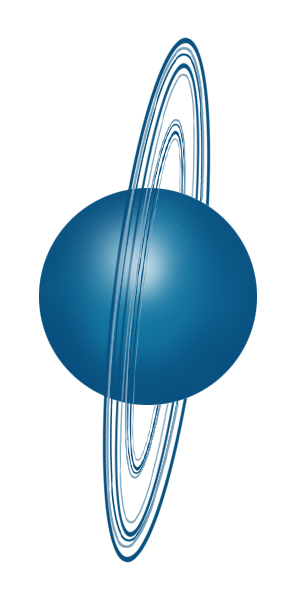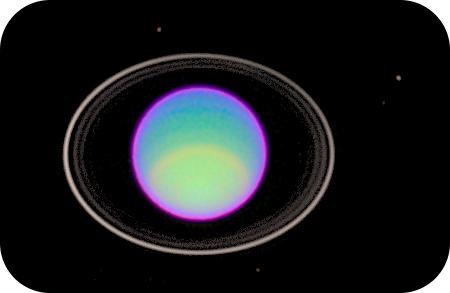What is this blue ball?
Uranus is so far away that there has been relatively little exploration of the planet. The closest approach was a flyby by Voyager 2 in 1986. Great images have also been taken by the Hubble Space Telescope.
Uranus
Uranus is named for the Greek god of the sky, the father of Saturn. Astronomers pronounce the name “YOOR-uh-nuhs.” Uranus was not known to ancient observers. The planet was first discovered with a telescope by the astronomer William Herschel in 1781.
Uranus is faint because it is very far away. Its distance from the sun is 2.8 billion kilometers (1.8 billion miles). A photon from the Sun takes about 2 hours and 40 minutes to reach Uranus. Uranus orbits the Sun once about every 84 Earth years.
An Icy Blue-Green Ball
Uranus is a lot like Jupiter and Saturn. The planet is composed mainly of hydrogen and helium. There is a thick layer of gas on the outside. Farther on the inside is liquid. But Uranus has a higher percentage of icy materials than Jupiter and Saturn. These materials include water, ammonia, and methane. Uranus is also different because of its blue-green color. Clouds of methane filter out red light. This leaves a blue-green color. The atmosphere of Uranus has bands of clouds. These clouds are hard to see in normal light. The result is that the planet looks like a plain blue ball.
Uranus is the least massive outer planet. Its mass is only about 14 times the mass of Earth. Like all of the outer planets, Uranus is much less dense than Earth. Gravity is actually weaker than on Earth’s surface. If you were at the top of the clouds on Uranus, you would weigh about 10 percent less than what you weigh on Earth.
The Sideways Planet
All of the planets rotate on their axes in the same direction that they move around the sun. Except for Uranus. Uranus is tilted on its side. Its axis is almost parallel to its orbit. So Uranus rolls along like a bowling ball as it revolves around the Sun. How did Uranus get this way? Scientists think that the planet was struck and knocked over by another planet-sized object. This collision probably took place billions of years ago.
Rings and Moons of Uranus
Uranus has a faint system of rings ( Figure below ). The rings circle the planet’s equator. However, Uranus is tilted on its side. So the rings are almost perpendicular to the planet’s orbit.
This image from the Hubble Space Telescope uses infrared light filters to show the faint rings of Uranus.
We have discovered 27 moons around Uranus. All but a few are named for characters from the plays of William Shakespeare. The five biggest moons of Uranus, Miranda, Ariel, Umbriel, Titania, and Oberon, are pictured below ( Figurebelow ).
The five biggest moons of Uranus: Miranda, Ariel, Umbriel, Titania, and Oberon.
Vocabulary
- Uranus : The seventh planet from the sun; a blue gas giant that is rotates sideways.
Summary
- Uranus is composed of hydrogen and helium. Methane clouds filter red light and give the planet a blue-green color.
- The rotational axis of Uranus is tilted almost parallel to its orbit.
- Uranus has rings that are nearly perpendicular to the planet’s orbit.
Practice
Use the resource below to answer the questions that follow.
- The Planet Uranus at http://www.youtube.com/watch?v=scvVpjRT-4M (7:34)
- When was Uranus discovered? Who found Uranus?
- How many moons does Uranus have?
- How long does it take Uranus to orbit the Sun?
- How does Uranus differ from the other large planets?
- Why does Uranus appear blue-green?
- Describe Uranus’ composition.
- Describe the axis of Uranus. What does it mean?
- How long is a day on Uranus?
- Explain how Uranus’ rings were discovered.
- How many rings does Uranus have?
Review
- Why is Uranus icy blue?
- Why is Uranus tilted on its side?
- Describe the rings of Uranus.



